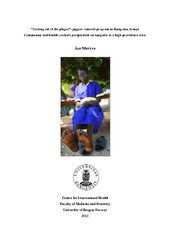"Getting rid of the plague": jiggers removal program in Bungoma, Kenya. Community and health workers perspectives on tungiasis in a high prevalence area.
Abstract
Objectives: Tungiasis is caused by a flea, tunga penetrans/ jiggers, which enters the epidermis of humans/ animals. The skin gets painful and itchy, and if untreated, bacterial infection occurs. Jiggers are easily transmitted among the poor living in urban slums and in rural and fishing communities. Millions are at risk worldwide. Fighting jiggers remains NGOs’ task. Bungoma Red Cross, Kenya conducts removal clinics since 2005. The study’s aim was to explore experiences with fighting the vermin. Methodology: Qualitative participatory research was performed in Bungoma County during a two-month fieldwork. In-depth interviews, group discussions, observation and informal talks were conducted with: NGO- and public health workers; persons affected by jiggers and keyinformants (e.g. teachers). 19 health-facility informants and 36 community-based informants were interviewed. Results: Those infected feel tortured by multiple penetrations on hands and feet which are painful and physically disabling, resulting in work-incapacity and school drop-out. People feel stigmatized, neglected and dependent on assistance to remove the jiggers. Children and elders are particularly vulnerable. Different traditional and modern methods are used for removing/ eradicating the flea. There is confusion about effective approaches and guidelines are lacking. Where the attack rate was extreme, reoccurrence after treatment was apparently inevitable. Animals were not perceived as reservoirs of jiggers. The government did not seem to pay attention to this vermin affecting several communities, and NGOs/ Bungoma Red Cross feel they are left alone. The program is time consuming and costly, and lacks manpower and medicine. Collaboration with government health-workers is necessary to sensitize and follow up the community, yet they also lack resources. Conclusion: Tungiasis is a debilitating problem affecting individuals’ households, and increasing the vicious circle of poverty. High-prevalence communities need coordinated measures by the public health sector to combat re-occurrence and environmental infestation. Research on prevalence, prevention and treatment is needed.
